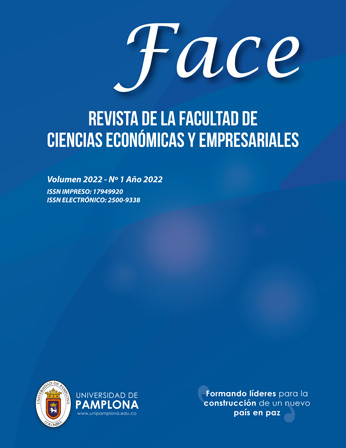Factores que explican el aumento del consumo de carne bovina por parte de las unidades familiares en la región Caribe de Colombia
DOI:
https://doi.org/10.24054/face.v22i1.1492Palabras clave:
cantidades, decisiones, edad, escolaridad,, ingresos, preferenciasResumen
Con el fin de determinar las variables que explican los aumentos del consumo de carne bovina en la Región Caribe de Colombia se realizó este estudio mediante información obtenida por parte de los responsables de las compras en los hogares. Con una encuesta aplicada a 337 personas responsables de las compras, seleccionados completamente al azar. El formulario se compuso de variables socioeconómicas de tipo cualitativo como: Edad, educación, estrato, número de miembros de la familia y cuantitativas como los ingresos, los precios y las cantidades consumidas. Se aplicaron estadísticas descriptivas, tablas de contingencia, análisis de correlación. Se hizo uso de la técnica econométrica de elección discreta tipo McFadden mediante un modelo tipo logit y el método de valoración contingente, los parámetros y la estimación del modelo se hicieron mediante el método de máxima verosimilitud. Los resultados permiten apreciar que un 54% de la muestra encuestada estaría dispuesta a aumentar el consumo, se explican por la edad, el género, el nivel de estudios, la ocupación de quien decide por las compras y las cantidades consumidas actualmente. La variable que en mayor grado explica el aumento del consumo es el género seguido por la cantidad consumida actualmente. Se concluye que la edad del consumidor presenta una relación inversa con la posibilidad de aumentar el consumo donde a mayor edad menos posibilidad de aumentar el consumo, debido a que los mayores consumos se presentan en edades que van desde los 30 a los 40 años.
Descargas
Referencias
Berges, M., & Casellas, K. (2008). Disposición a pagar por atributos de calidad. Un estudio aplicado al agregado de nutrientes en la leche fluida. Asociación Argentina de Economía Política. XLIII Reunión Anual. ISSN 1852-0022 ISBN 978-987-99570-6-6. Disponible en: http://nulan.mdp.edu.ar/1030/1/00362.pdf
Chary, A., & Burkart, S. (2017). Disposición a pagar por carne de res con menor huella ambiental y bienestar animal en Cali. Centro Internacional de Agricultura Tropical (CIAT). Documento de trabajo informe. Disponible en: [Enlace al documento]
Domencich, T. A., & McFadden, D. (1975). The measurement of welfare effects in discrete choice models. Journal of Economics.
Fedegan. (2020). Federación Colombiana de Ganaderos. Estadísticas del sector ganadero. Disponible en: https://www.fedegan.org.co/estadisticas/consumo-0
FAO. (2019). Organización de las Naciones Unidas para la Agricultura y la Alimentación. Índice de precios de los alimentos. Disponible en: http://www.fao.org/worldfoodsituation/foodpricesindex/es/
Gujarati, D. (2006). Econometría (4ª ed.). México: McGraw Hill.
Haab, T. C., & McConnell, K. E. (2002). Valuing Environmental and Natural Resources. Cheltenham, UK: Edward Elgar Publishing.
Hanemann, W. M. (1984). Welfare evaluations in contingent valuation experiments with discrete responses. American Journal of Agricultural Economics, 66, 332-341.
López, A. (2003). Manual Para la Preparación y Venta de Frutas y Hortalizas: Del Campo al Mercado. FAO. ISBN 92-5-304991-X. Recuperado de http://books.google.com/books?id=xf1zTXxRGMgC&pgis=1
McFadden, D. (1973). Conditional logit analysis of qualitative choice behavior. En P. Zarembka (Ed.), Frontiers in Econometrics. Nueva York: Academic Press.
Maddala, G. S., & Nelson, F. (1975). Switching regression models with exogenous and endogenous switching. Proceedings of the American Statistical Association (Business Section), pp. 423-426.
Maddala, G. (1996). Introducción a la Econometría (2ª ed.). México: Prentice-Hall.
Martínez, R., Avendaño, B., & Acosta, A. (2012). Determinantes de la adopción de estándares en el subsector hortícola del Noroeste de México. Revista de Ciencias Agrícolas, 22(1), 272-281.
McFadden, D. (1975). The revealed preferences of government bureaucracy. Bell Journal of Economics, 6, 401-416.
Nicholson, W. (1997). Teoría Microeconómica: Principios y Aplicaciones. Editorial McGraw Hill.
Nuevo Siglo. (2020). Consumo de carne cae por altos costos y cambio de hábitos. Disponible en: https://www.elnuevosiglo.com.co/articulos/11-25-2020-consumo-de-carne-cae-por-altos-costos-y-cambio-de-habitos
Plan Estratégico de Ciencia, Tecnología e Innovación del Sector Agropecuario Colombiano (PECTIA) (2017-2027). Disponible en: https://minciencias.gov.co/sites/default/files/upload/noticias/pectia-2017-actualizado.pdf
Pindyck, R., & Rubinfeld, D. (2001). Econometría: Modelos y pronósticos (4ª ed.). México: McGraw Hill.
Samuelson, P. A. (1948). Consumption theory in terms of revealed preference. Journal of Political Economy, 15(60), 243-253. Disponible en: https://www.jstor.org/stable/pdf/2549561.pdf?seq=1#page_scan_tab_contents
Tudela, J., Martínez, M., Valdivia, R., Portillo, M., & Romo, J. M. (1999). Modelos de elección discreta en la valoración económica de áreas naturales protegidas. Revista Mexicana de Ciencias Agrícolas y de los Recursos Naturales.
Descargas
Publicado
Número
Sección
Licencia
Derechos de autor 2022 FACE: Revista de la Facultad de Ciencias Económicas y Empresariales

Esta obra está bajo una licencia internacional Creative Commons Atribución-NoComercial-CompartirIgual 4.0.





